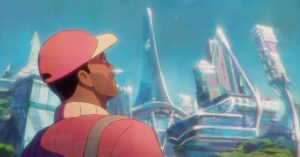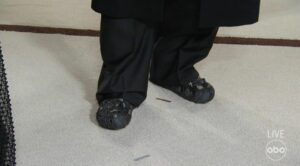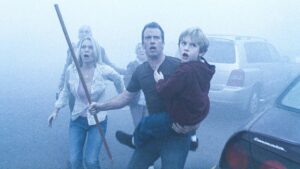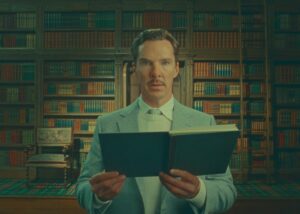Godzilla vs. Kong is a 113-minute argument for movies projected on giant screens in front of crowds of people. It’s a smooth-brained good time. Depending on local pandemic recovery progress and restrictions, it will either triumphantly welcome moviegoers back into theaters with tremendous spectacle, or make the wait hurt that much more, as they watch it on HBO Max instead. I watched it at home, on my 55-inch TV, absolutely furious that I couldn’t see it in a theater, or at the very least, project it on the side of my apartment building. But I couldn’t stay mad for long, because I was too busy cheering out loud at the spectacle in front of me.
Deep into the big monster brawl that gives the movie its name, King Kong dislocates his shoulder. What follows may be my favorite buck-wild moment in a film completely stuffed with buck-freaking-wild moments: Kong lumbers over to the nearest skyscraper, squares up, and slams his shoulder against it to pop it back into place. I haven’t missed a movie theater more than I did in that moment — Godzilla vs. Kong is a gorgeous, kinetic spectacle that’s so effectively big in its loud colors and ridiculous choreography that any screen outside of a multiplex feels too small for it.
Directed by Adam Wingard, best known for his surprising, playful thrillers You’re Next and The Guest, Godzilla vs. Kong succeeds mostly by being incredibly straightforward. The film promises a brawl between Godzilla and King Kong, and boy, does it deliver. Very little of the film feels extraneous, even the ridiculous moments of exposition and the various asides to its talented cast of human characters. For a movie that’s mostly nonsense, it has a rock-solid construction.

Unlike the previous Godzilla and Kong films in the “MonsterVerse” that kicked off with 2014’s Godzilla, Godzilla vs. Kong makes a hard tonal pivot away from self-serious disaster/war epics. Instead, it’s a throwback to adventure stories of yore. The film’s plot revolves around the discovery that the Hollow Earth — a very old concept that the Earth might be hiding a whole other world within it — is real. Walter Simmons (Demián Bichir), the CEO of Apex Cybernetics, believes he can find a new renewable energy source there, one that can help mankind thrive in a world beset by Titans.
To that end, he assembles a team led by Dr. Nathan Lind (Alexander Skarsgård) to head toward the planet’s core and find the secret world. Only problem: they need King Kong, because they believe the Hollow Earth is his home, and that it’s likely full of monsters they’ll need his help with. Kong — now older and larger than he was in the 1970s setting of 2017’s Kong: Skull Island — is currently under observation by Dr. Ilene Andrews (Rebecca Hall) on Skull Island, where he’s made a friend: Ilene’s adopted daughter Jia, an Iwi girl who can talk to Kong.
Ilene reluctantly signs up at the prospect of reuniting Kong with his homeland, but warns Nathan of a big problem: Kong has an ancient rivalry with Godzilla, a grudge as old as time that will violently explode to the forefront the second Kong leaves Skull Island. Godzilla, she warns, will know he’s out and about.
From there, the movie proceeds along parallel tracks, as Nathan and Ilene escort Kong to Hollow Earth, while Madison Russell (Millie Bobbie Brown, reprising her role from Godzilla: King of the Monsters) teams up with conspiracy podcaster Bernie Hayes (Brian Tyree Henry) to figure out why Godzilla is acting erratically and attacking towns unprovoked. The former track is Journey to the Center of the Earth, the latter track is Goonies, and when the two stories meet, the movie stops being mere fun, and starts being worthy of fist-pumping glee.
While Godzilla vs. Kong has a large, accomplished cast of human actors who are very busy doing entertaining things, the monsters are the protagonists. They’ve both had their designs slightly tweaked to make them more expressive and anthropomorphized. Their movements are more dramatic and weirdly human, and their expressions are nuanced enough to make it clear that the big lizard and the giant monkey are pissed as hell. The amount of work that goes into making Kong clocking Godzilla with a giant haymaker absolutely cheer-worthy is astounding — these creatures don’t look real, but they’re believable, and that’s tremendous.
Part of this is from the film’s clever staging, which takes advantage of the human cast to give exciting new angles on the monster fights beyond simple scale. In one scene, a fighter-jet pilot desperately rockets off an aircraft carrier that’s being torn to bits, and the brawl that’s destroying it is visible in the plane’s rear windshield. In another, an experimental aircraft explodes out of the Hollow Earth and nearly into both monsters’ jaws, in a Star Tours-style theme-park thrill that gives away the game — this is a ride, not a story. Yet in its careful choreography, understanding of space, and frankly stunning backdrop of a neon-drenched Hong Kong, it is absolutely cinema.

Godzilla vs. Kong is so attuned to thrills, it almost feels out of step with the movies that came before it in the franchise. Those were largely about shock and awe. Godzilla vs. Kong has a different dynamic: It razes cities with a casualness that the prior movies in the series played for horror. Part of this might be a smart recalibration for human-centric plots that felt like dead weight holding back monstrous thrills. But it’s also necessary if this reboot franchise is going to head in the direction of the franchise it’s re-inventing. Godzilla vs. Kong is the logical next step in a strange fictional world where a destructive dinosaur that breathes atomic fire can be conceived of as a savior to humanity, the way he was at the end of 2014’s Godzilla.
If there’s an overriding theme to the four movies in Warner Brothers’ MonsterVerse, it’s that — to borrow an internet meme — we are the virus. 2019’s Godzilla: King of the Monsters makes this the text of the tetralogy: It revolves around eco-terrorists who believe the Titans, as the giant monsters are called, are the rightful heirs to the planet, here to right the natural order after centuries of humanity’s meddling. These ideas are wildly half-baked and never lead to any compelling follow-through, but Godzilla vs. Kong smartly zeroes in on the only solid conclusion that could be drawn from this setup. Despite this film’s focus on a battle royale between two storied titans, these movies are about how little we matter as a species, and how the worst damage we inflict is when we insist we do.
Godzilla vs. Kong will be in theaters and on HBO Max on Wednesday, March 31.
Source: https://www.polygon.com/reviews/22356658/godzilla-vs-kong-review
- ADvantage
- Adventure
- aircraft
- around
- AWE
- Battle
- BEST
- Building
- ceo
- Cities
- Conspiracy
- construction
- content
- dead
- DID
- discovery
- energy
- fights
- Figure
- Film
- films
- Fire
- Focus
- Franchise
- full
- fun
- game
- good
- head
- here
- Home
- Hong Kong
- How
- HTTPS
- Internet
- IT
- King
- large
- lead
- Led
- local
- Long
- Making
- March
- movie
- Movies
- Neon
- order
- Other
- pandemic
- People
- pilot
- Pivot
- planet
- project
- recovery
- renewable energy
- Scale
- Screen
- Series
- setting
- Signs
- Simple
- small
- smart
- So
- Space
- stay
- Stories
- Theater
- theme
- time
- track
- tv
- virus
- wait
- Watch
- WHO
- Wikipedia
- within
- Work
- world
- youtube










